Story-Telling as a Counselling Form
VerifiedAdded on 2022/11/13
|7
|1909
|106
AI Summary
This article discusses the use of story-telling as a counselling form and its effectiveness in therapy. It explores different theoretical approaches and their limitations. The article emphasizes the importance of narratives in shaping our beliefs and identity.
Contribute Materials
Your contribution can guide someone’s learning journey. Share your
documents today.
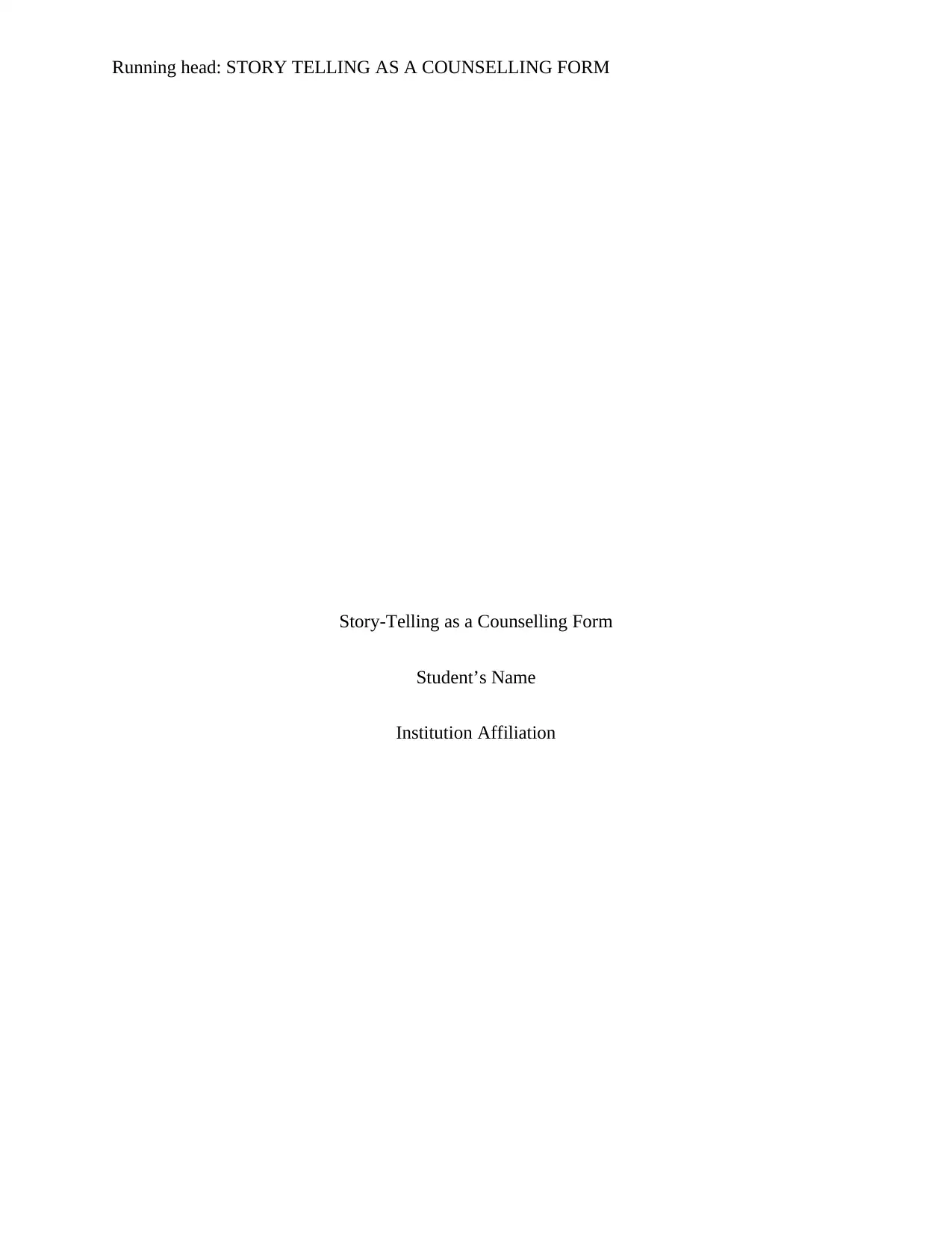
Running head: STORY TELLING AS A COUNSELLING FORM
Story-Telling as a Counselling Form
Student’s Name
Institution Affiliation
Story-Telling as a Counselling Form
Student’s Name
Institution Affiliation
Secure Best Marks with AI Grader
Need help grading? Try our AI Grader for instant feedback on your assignments.
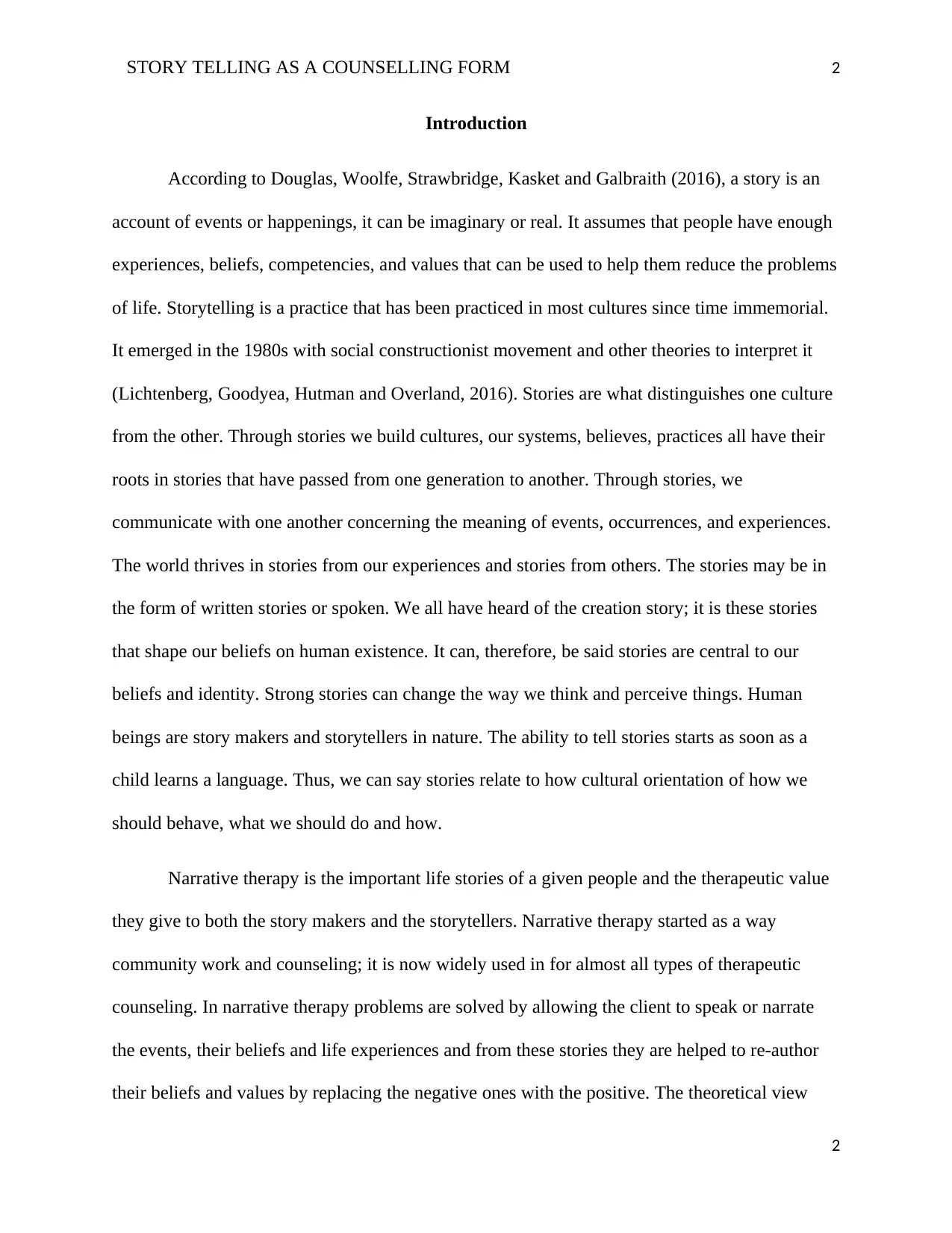
STORY TELLING AS A COUNSELLING FORM 2
Introduction
According to Douglas, Woolfe, Strawbridge, Kasket and Galbraith (2016), a story is an
account of events or happenings, it can be imaginary or real. It assumes that people have enough
experiences, beliefs, competencies, and values that can be used to help them reduce the problems
of life. Storytelling is a practice that has been practiced in most cultures since time immemorial.
It emerged in the 1980s with social constructionist movement and other theories to interpret it
(Lichtenberg, Goodyea, Hutman and Overland, 2016). Stories are what distinguishes one culture
from the other. Through stories we build cultures, our systems, believes, practices all have their
roots in stories that have passed from one generation to another. Through stories, we
communicate with one another concerning the meaning of events, occurrences, and experiences.
The world thrives in stories from our experiences and stories from others. The stories may be in
the form of written stories or spoken. We all have heard of the creation story; it is these stories
that shape our beliefs on human existence. It can, therefore, be said stories are central to our
beliefs and identity. Strong stories can change the way we think and perceive things. Human
beings are story makers and storytellers in nature. The ability to tell stories starts as soon as a
child learns a language. Thus, we can say stories relate to how cultural orientation of how we
should behave, what we should do and how.
Narrative therapy is the important life stories of a given people and the therapeutic value
they give to both the story makers and the storytellers. Narrative therapy started as a way
community work and counseling; it is now widely used in for almost all types of therapeutic
counseling. In narrative therapy problems are solved by allowing the client to speak or narrate
the events, their beliefs and life experiences and from these stories they are helped to re-author
their beliefs and values by replacing the negative ones with the positive. The theoretical view
2
Introduction
According to Douglas, Woolfe, Strawbridge, Kasket and Galbraith (2016), a story is an
account of events or happenings, it can be imaginary or real. It assumes that people have enough
experiences, beliefs, competencies, and values that can be used to help them reduce the problems
of life. Storytelling is a practice that has been practiced in most cultures since time immemorial.
It emerged in the 1980s with social constructionist movement and other theories to interpret it
(Lichtenberg, Goodyea, Hutman and Overland, 2016). Stories are what distinguishes one culture
from the other. Through stories we build cultures, our systems, believes, practices all have their
roots in stories that have passed from one generation to another. Through stories, we
communicate with one another concerning the meaning of events, occurrences, and experiences.
The world thrives in stories from our experiences and stories from others. The stories may be in
the form of written stories or spoken. We all have heard of the creation story; it is these stories
that shape our beliefs on human existence. It can, therefore, be said stories are central to our
beliefs and identity. Strong stories can change the way we think and perceive things. Human
beings are story makers and storytellers in nature. The ability to tell stories starts as soon as a
child learns a language. Thus, we can say stories relate to how cultural orientation of how we
should behave, what we should do and how.
Narrative therapy is the important life stories of a given people and the therapeutic value
they give to both the story makers and the storytellers. Narrative therapy started as a way
community work and counseling; it is now widely used in for almost all types of therapeutic
counseling. In narrative therapy problems are solved by allowing the client to speak or narrate
the events, their beliefs and life experiences and from these stories they are helped to re-author
their beliefs and values by replacing the negative ones with the positive. The theoretical view
2
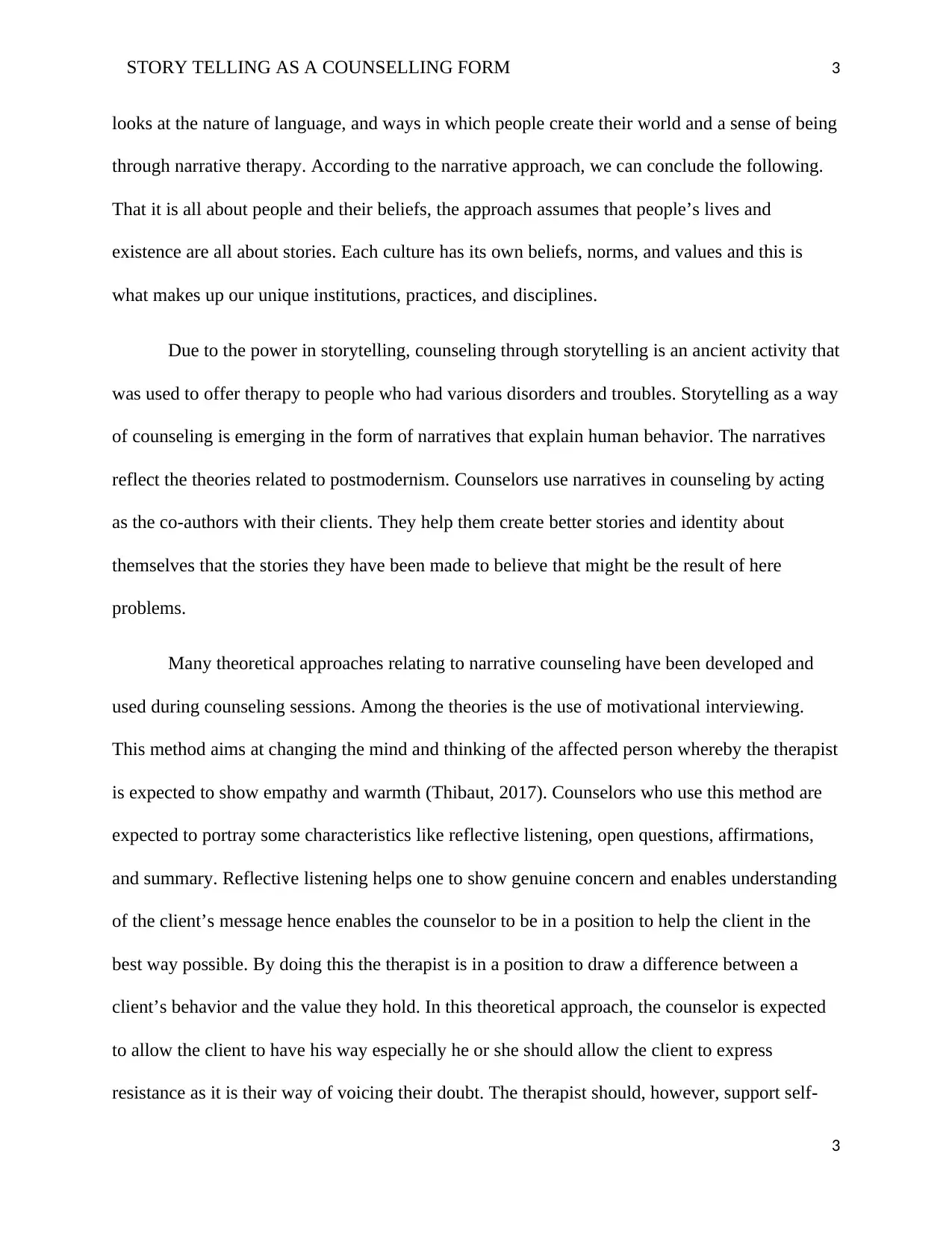
STORY TELLING AS A COUNSELLING FORM 3
looks at the nature of language, and ways in which people create their world and a sense of being
through narrative therapy. According to the narrative approach, we can conclude the following.
That it is all about people and their beliefs, the approach assumes that people’s lives and
existence are all about stories. Each culture has its own beliefs, norms, and values and this is
what makes up our unique institutions, practices, and disciplines.
Due to the power in storytelling, counseling through storytelling is an ancient activity that
was used to offer therapy to people who had various disorders and troubles. Storytelling as a way
of counseling is emerging in the form of narratives that explain human behavior. The narratives
reflect the theories related to postmodernism. Counselors use narratives in counseling by acting
as the co-authors with their clients. They help them create better stories and identity about
themselves that the stories they have been made to believe that might be the result of here
problems.
Many theoretical approaches relating to narrative counseling have been developed and
used during counseling sessions. Among the theories is the use of motivational interviewing.
This method aims at changing the mind and thinking of the affected person whereby the therapist
is expected to show empathy and warmth (Thibaut, 2017). Counselors who use this method are
expected to portray some characteristics like reflective listening, open questions, affirmations,
and summary. Reflective listening helps one to show genuine concern and enables understanding
of the client’s message hence enables the counselor to be in a position to help the client in the
best way possible. By doing this the therapist is in a position to draw a difference between a
client’s behavior and the value they hold. In this theoretical approach, the counselor is expected
to allow the client to have his way especially he or she should allow the client to express
resistance as it is their way of voicing their doubt. The therapist should, however, support self-
3
looks at the nature of language, and ways in which people create their world and a sense of being
through narrative therapy. According to the narrative approach, we can conclude the following.
That it is all about people and their beliefs, the approach assumes that people’s lives and
existence are all about stories. Each culture has its own beliefs, norms, and values and this is
what makes up our unique institutions, practices, and disciplines.
Due to the power in storytelling, counseling through storytelling is an ancient activity that
was used to offer therapy to people who had various disorders and troubles. Storytelling as a way
of counseling is emerging in the form of narratives that explain human behavior. The narratives
reflect the theories related to postmodernism. Counselors use narratives in counseling by acting
as the co-authors with their clients. They help them create better stories and identity about
themselves that the stories they have been made to believe that might be the result of here
problems.
Many theoretical approaches relating to narrative counseling have been developed and
used during counseling sessions. Among the theories is the use of motivational interviewing.
This method aims at changing the mind and thinking of the affected person whereby the therapist
is expected to show empathy and warmth (Thibaut, 2017). Counselors who use this method are
expected to portray some characteristics like reflective listening, open questions, affirmations,
and summary. Reflective listening helps one to show genuine concern and enables understanding
of the client’s message hence enables the counselor to be in a position to help the client in the
best way possible. By doing this the therapist is in a position to draw a difference between a
client’s behavior and the value they hold. In this theoretical approach, the counselor is expected
to allow the client to have his way especially he or she should allow the client to express
resistance as it is their way of voicing their doubt. The therapist should, however, support self-
3
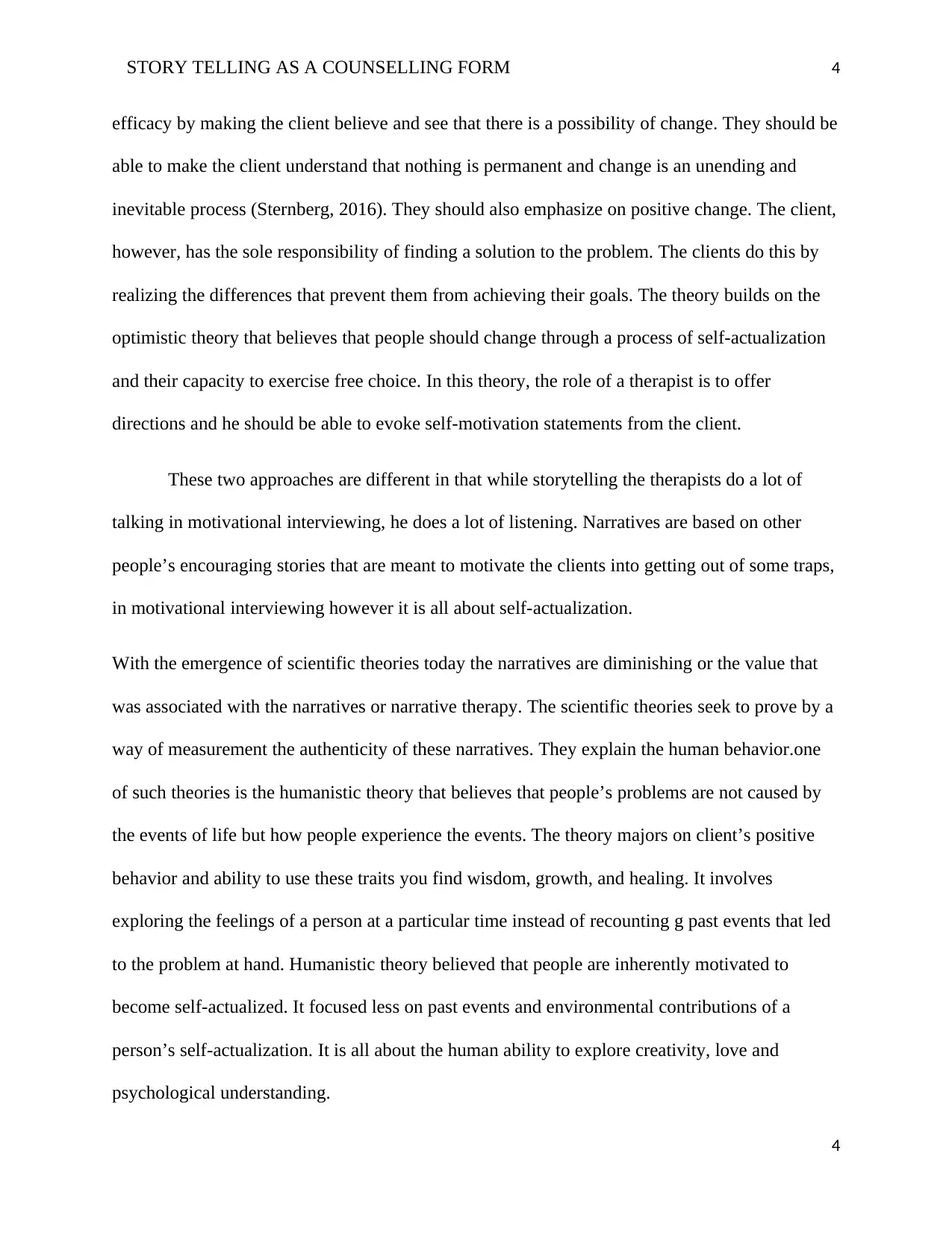
STORY TELLING AS A COUNSELLING FORM 4
efficacy by making the client believe and see that there is a possibility of change. They should be
able to make the client understand that nothing is permanent and change is an unending and
inevitable process (Sternberg, 2016). They should also emphasize on positive change. The client,
however, has the sole responsibility of finding a solution to the problem. The clients do this by
realizing the differences that prevent them from achieving their goals. The theory builds on the
optimistic theory that believes that people should change through a process of self-actualization
and their capacity to exercise free choice. In this theory, the role of a therapist is to offer
directions and he should be able to evoke self-motivation statements from the client.
These two approaches are different in that while storytelling the therapists do a lot of
talking in motivational interviewing, he does a lot of listening. Narratives are based on other
people’s encouraging stories that are meant to motivate the clients into getting out of some traps,
in motivational interviewing however it is all about self-actualization.
With the emergence of scientific theories today the narratives are diminishing or the value that
was associated with the narratives or narrative therapy. The scientific theories seek to prove by a
way of measurement the authenticity of these narratives. They explain the human behavior.one
of such theories is the humanistic theory that believes that people’s problems are not caused by
the events of life but how people experience the events. The theory majors on client’s positive
behavior and ability to use these traits you find wisdom, growth, and healing. It involves
exploring the feelings of a person at a particular time instead of recounting g past events that led
to the problem at hand. Humanistic theory believed that people are inherently motivated to
become self-actualized. It focused less on past events and environmental contributions of a
person’s self-actualization. It is all about the human ability to explore creativity, love and
psychological understanding.
4
efficacy by making the client believe and see that there is a possibility of change. They should be
able to make the client understand that nothing is permanent and change is an unending and
inevitable process (Sternberg, 2016). They should also emphasize on positive change. The client,
however, has the sole responsibility of finding a solution to the problem. The clients do this by
realizing the differences that prevent them from achieving their goals. The theory builds on the
optimistic theory that believes that people should change through a process of self-actualization
and their capacity to exercise free choice. In this theory, the role of a therapist is to offer
directions and he should be able to evoke self-motivation statements from the client.
These two approaches are different in that while storytelling the therapists do a lot of
talking in motivational interviewing, he does a lot of listening. Narratives are based on other
people’s encouraging stories that are meant to motivate the clients into getting out of some traps,
in motivational interviewing however it is all about self-actualization.
With the emergence of scientific theories today the narratives are diminishing or the value that
was associated with the narratives or narrative therapy. The scientific theories seek to prove by a
way of measurement the authenticity of these narratives. They explain the human behavior.one
of such theories is the humanistic theory that believes that people’s problems are not caused by
the events of life but how people experience the events. The theory majors on client’s positive
behavior and ability to use these traits you find wisdom, growth, and healing. It involves
exploring the feelings of a person at a particular time instead of recounting g past events that led
to the problem at hand. Humanistic theory believed that people are inherently motivated to
become self-actualized. It focused less on past events and environmental contributions of a
person’s self-actualization. It is all about the human ability to explore creativity, love and
psychological understanding.
4
Secure Best Marks with AI Grader
Need help grading? Try our AI Grader for instant feedback on your assignments.
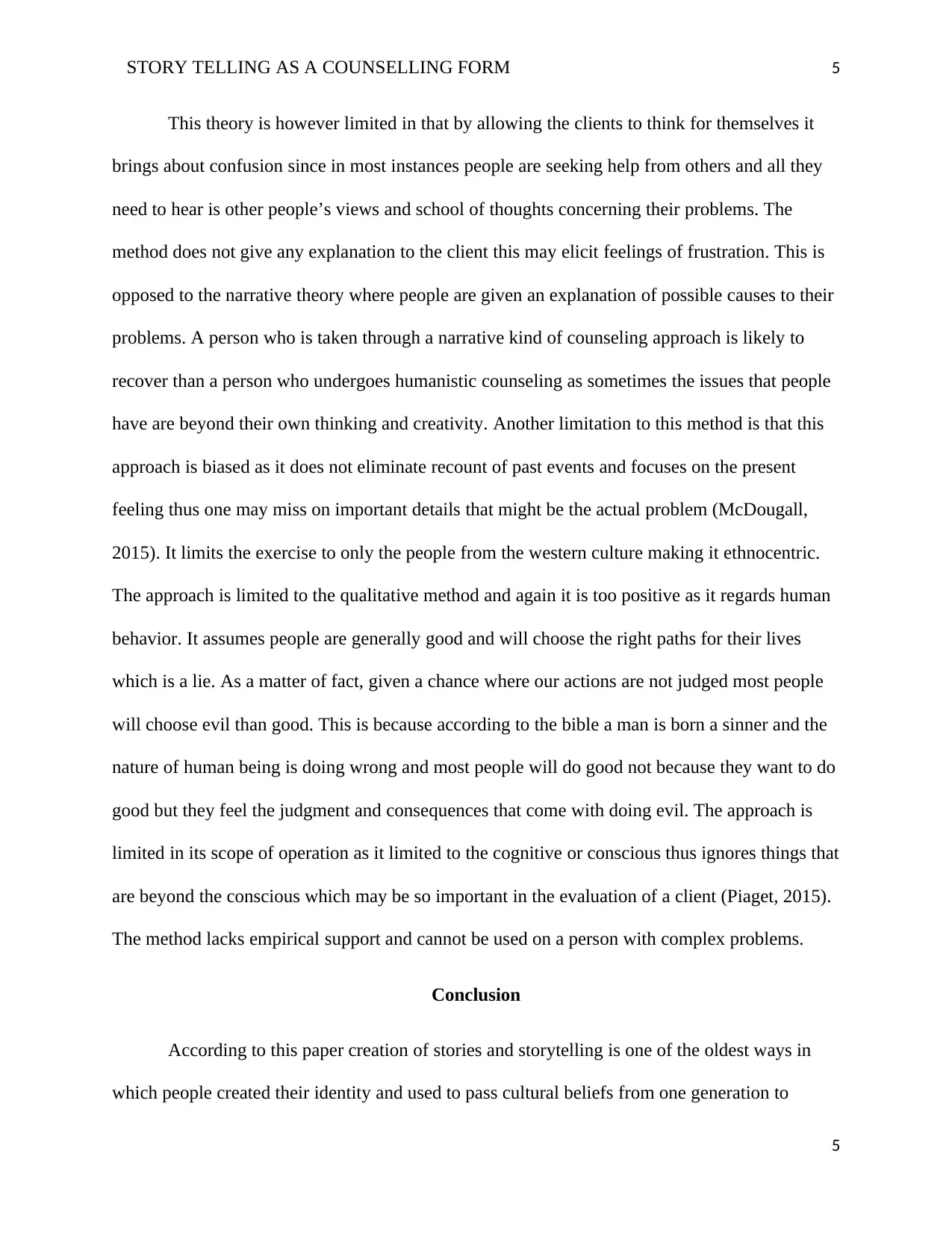
STORY TELLING AS A COUNSELLING FORM 5
This theory is however limited in that by allowing the clients to think for themselves it
brings about confusion since in most instances people are seeking help from others and all they
need to hear is other people’s views and school of thoughts concerning their problems. The
method does not give any explanation to the client this may elicit feelings of frustration. This is
opposed to the narrative theory where people are given an explanation of possible causes to their
problems. A person who is taken through a narrative kind of counseling approach is likely to
recover than a person who undergoes humanistic counseling as sometimes the issues that people
have are beyond their own thinking and creativity. Another limitation to this method is that this
approach is biased as it does not eliminate recount of past events and focuses on the present
feeling thus one may miss on important details that might be the actual problem (McDougall,
2015). It limits the exercise to only the people from the western culture making it ethnocentric.
The approach is limited to the qualitative method and again it is too positive as it regards human
behavior. It assumes people are generally good and will choose the right paths for their lives
which is a lie. As a matter of fact, given a chance where our actions are not judged most people
will choose evil than good. This is because according to the bible a man is born a sinner and the
nature of human being is doing wrong and most people will do good not because they want to do
good but they feel the judgment and consequences that come with doing evil. The approach is
limited in its scope of operation as it limited to the cognitive or conscious thus ignores things that
are beyond the conscious which may be so important in the evaluation of a client (Piaget, 2015).
The method lacks empirical support and cannot be used on a person with complex problems.
Conclusion
According to this paper creation of stories and storytelling is one of the oldest ways in
which people created their identity and used to pass cultural beliefs from one generation to
5
This theory is however limited in that by allowing the clients to think for themselves it
brings about confusion since in most instances people are seeking help from others and all they
need to hear is other people’s views and school of thoughts concerning their problems. The
method does not give any explanation to the client this may elicit feelings of frustration. This is
opposed to the narrative theory where people are given an explanation of possible causes to their
problems. A person who is taken through a narrative kind of counseling approach is likely to
recover than a person who undergoes humanistic counseling as sometimes the issues that people
have are beyond their own thinking and creativity. Another limitation to this method is that this
approach is biased as it does not eliminate recount of past events and focuses on the present
feeling thus one may miss on important details that might be the actual problem (McDougall,
2015). It limits the exercise to only the people from the western culture making it ethnocentric.
The approach is limited to the qualitative method and again it is too positive as it regards human
behavior. It assumes people are generally good and will choose the right paths for their lives
which is a lie. As a matter of fact, given a chance where our actions are not judged most people
will choose evil than good. This is because according to the bible a man is born a sinner and the
nature of human being is doing wrong and most people will do good not because they want to do
good but they feel the judgment and consequences that come with doing evil. The approach is
limited in its scope of operation as it limited to the cognitive or conscious thus ignores things that
are beyond the conscious which may be so important in the evaluation of a client (Piaget, 2015).
The method lacks empirical support and cannot be used on a person with complex problems.
Conclusion
According to this paper creation of stories and storytelling is one of the oldest ways in
which people created their identity and used to pass cultural beliefs from one generation to
5
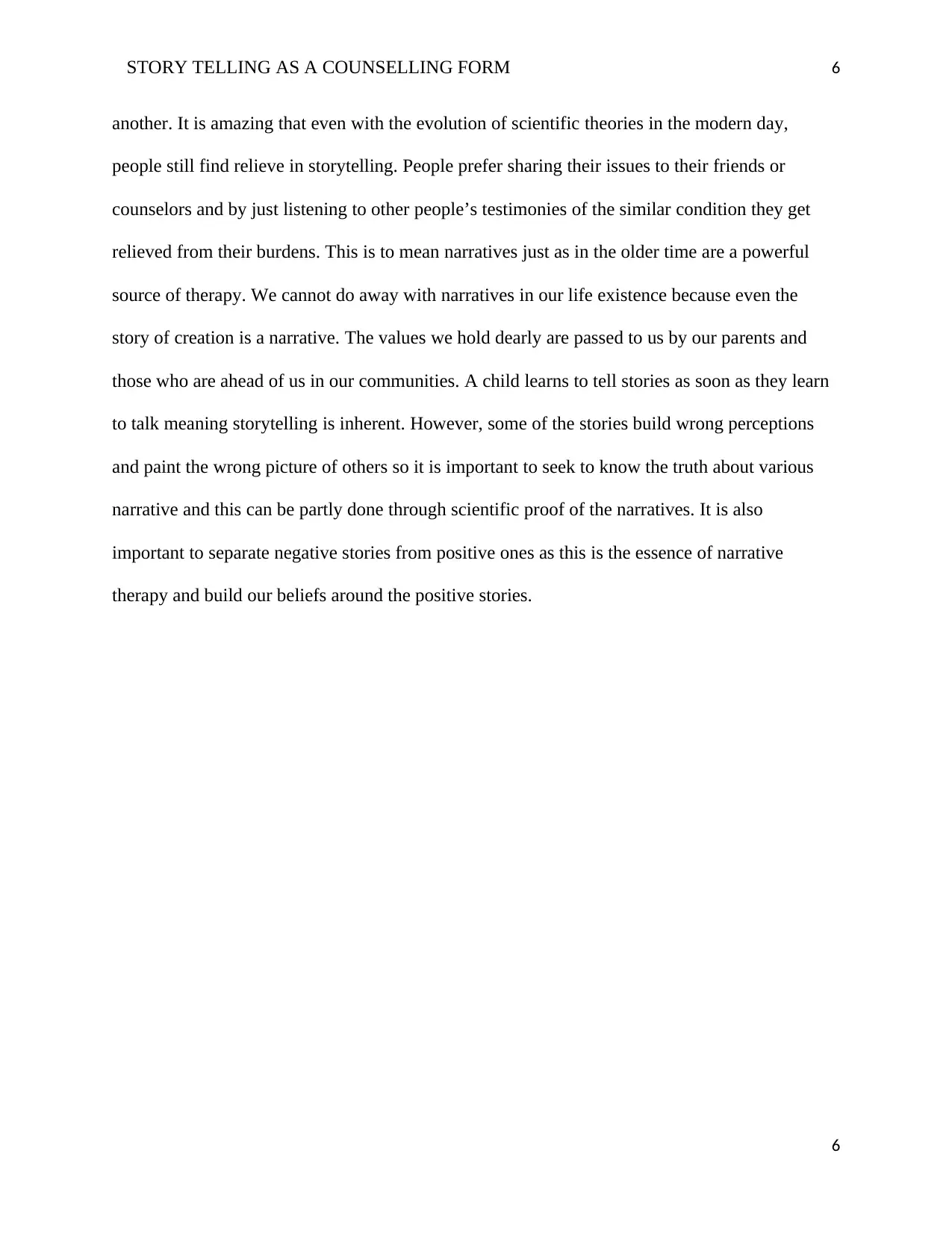
STORY TELLING AS A COUNSELLING FORM 6
another. It is amazing that even with the evolution of scientific theories in the modern day,
people still find relieve in storytelling. People prefer sharing their issues to their friends or
counselors and by just listening to other people’s testimonies of the similar condition they get
relieved from their burdens. This is to mean narratives just as in the older time are a powerful
source of therapy. We cannot do away with narratives in our life existence because even the
story of creation is a narrative. The values we hold dearly are passed to us by our parents and
those who are ahead of us in our communities. A child learns to tell stories as soon as they learn
to talk meaning storytelling is inherent. However, some of the stories build wrong perceptions
and paint the wrong picture of others so it is important to seek to know the truth about various
narrative and this can be partly done through scientific proof of the narratives. It is also
important to separate negative stories from positive ones as this is the essence of narrative
therapy and build our beliefs around the positive stories.
6
another. It is amazing that even with the evolution of scientific theories in the modern day,
people still find relieve in storytelling. People prefer sharing their issues to their friends or
counselors and by just listening to other people’s testimonies of the similar condition they get
relieved from their burdens. This is to mean narratives just as in the older time are a powerful
source of therapy. We cannot do away with narratives in our life existence because even the
story of creation is a narrative. The values we hold dearly are passed to us by our parents and
those who are ahead of us in our communities. A child learns to tell stories as soon as they learn
to talk meaning storytelling is inherent. However, some of the stories build wrong perceptions
and paint the wrong picture of others so it is important to seek to know the truth about various
narrative and this can be partly done through scientific proof of the narratives. It is also
important to separate negative stories from positive ones as this is the essence of narrative
therapy and build our beliefs around the positive stories.
6
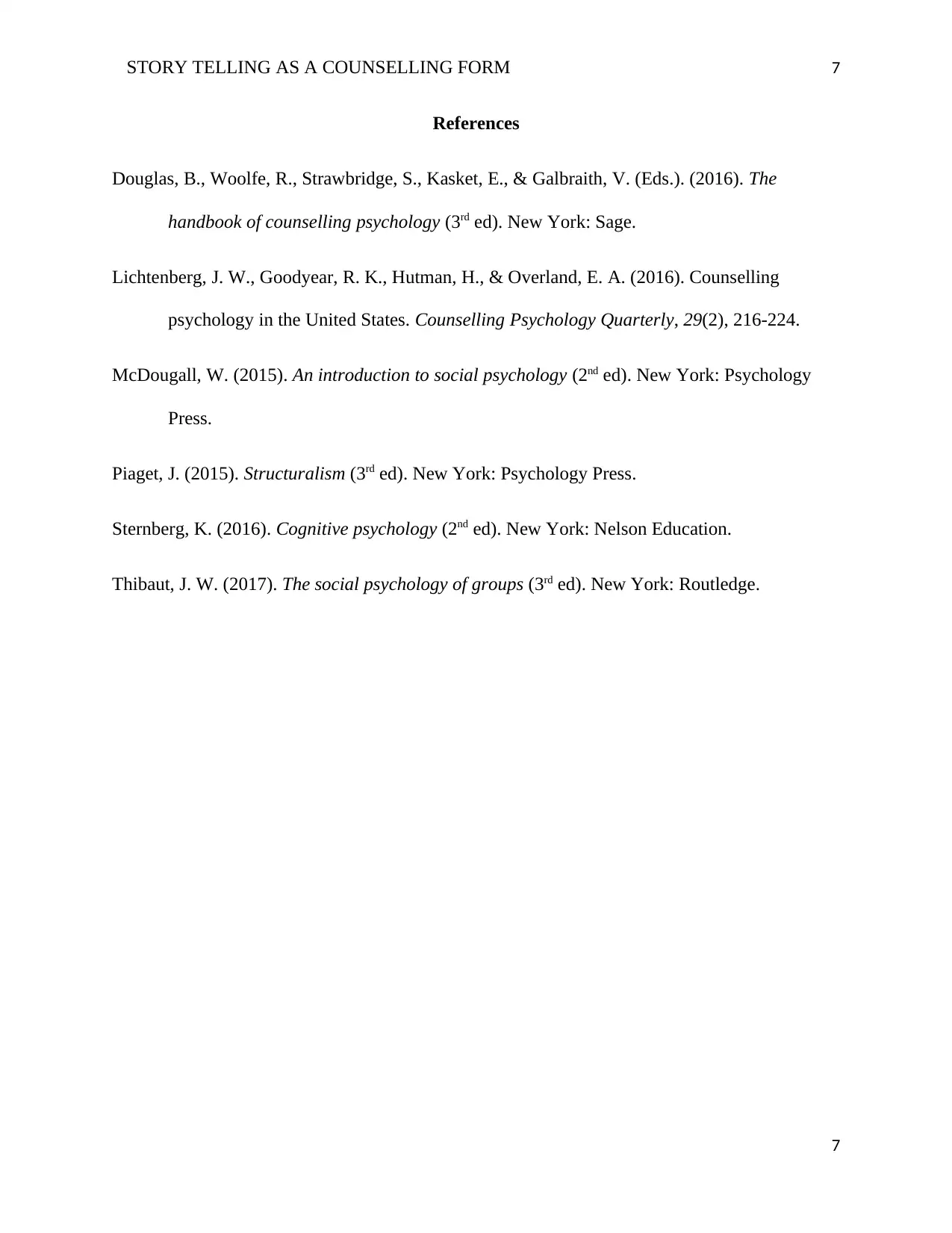
STORY TELLING AS A COUNSELLING FORM 7
References
Douglas, B., Woolfe, R., Strawbridge, S., Kasket, E., & Galbraith, V. (Eds.). (2016). The
handbook of counselling psychology (3rd ed). New York: Sage.
Lichtenberg, J. W., Goodyear, R. K., Hutman, H., & Overland, E. A. (2016). Counselling
psychology in the United States. Counselling Psychology Quarterly, 29(2), 216-224.
McDougall, W. (2015). An introduction to social psychology (2nd ed). New York: Psychology
Press.
Piaget, J. (2015). Structuralism (3rd ed). New York: Psychology Press.
Sternberg, K. (2016). Cognitive psychology (2nd ed). New York: Nelson Education.
Thibaut, J. W. (2017). The social psychology of groups (3rd ed). New York: Routledge.
7
References
Douglas, B., Woolfe, R., Strawbridge, S., Kasket, E., & Galbraith, V. (Eds.). (2016). The
handbook of counselling psychology (3rd ed). New York: Sage.
Lichtenberg, J. W., Goodyear, R. K., Hutman, H., & Overland, E. A. (2016). Counselling
psychology in the United States. Counselling Psychology Quarterly, 29(2), 216-224.
McDougall, W. (2015). An introduction to social psychology (2nd ed). New York: Psychology
Press.
Piaget, J. (2015). Structuralism (3rd ed). New York: Psychology Press.
Sternberg, K. (2016). Cognitive psychology (2nd ed). New York: Nelson Education.
Thibaut, J. W. (2017). The social psychology of groups (3rd ed). New York: Routledge.
7
1 out of 7
Related Documents
Your All-in-One AI-Powered Toolkit for Academic Success.
+13062052269
info@desklib.com
Available 24*7 on WhatsApp / Email
![[object Object]](/_next/static/media/star-bottom.7253800d.svg)
Unlock your academic potential
© 2024 | Zucol Services PVT LTD | All rights reserved.




